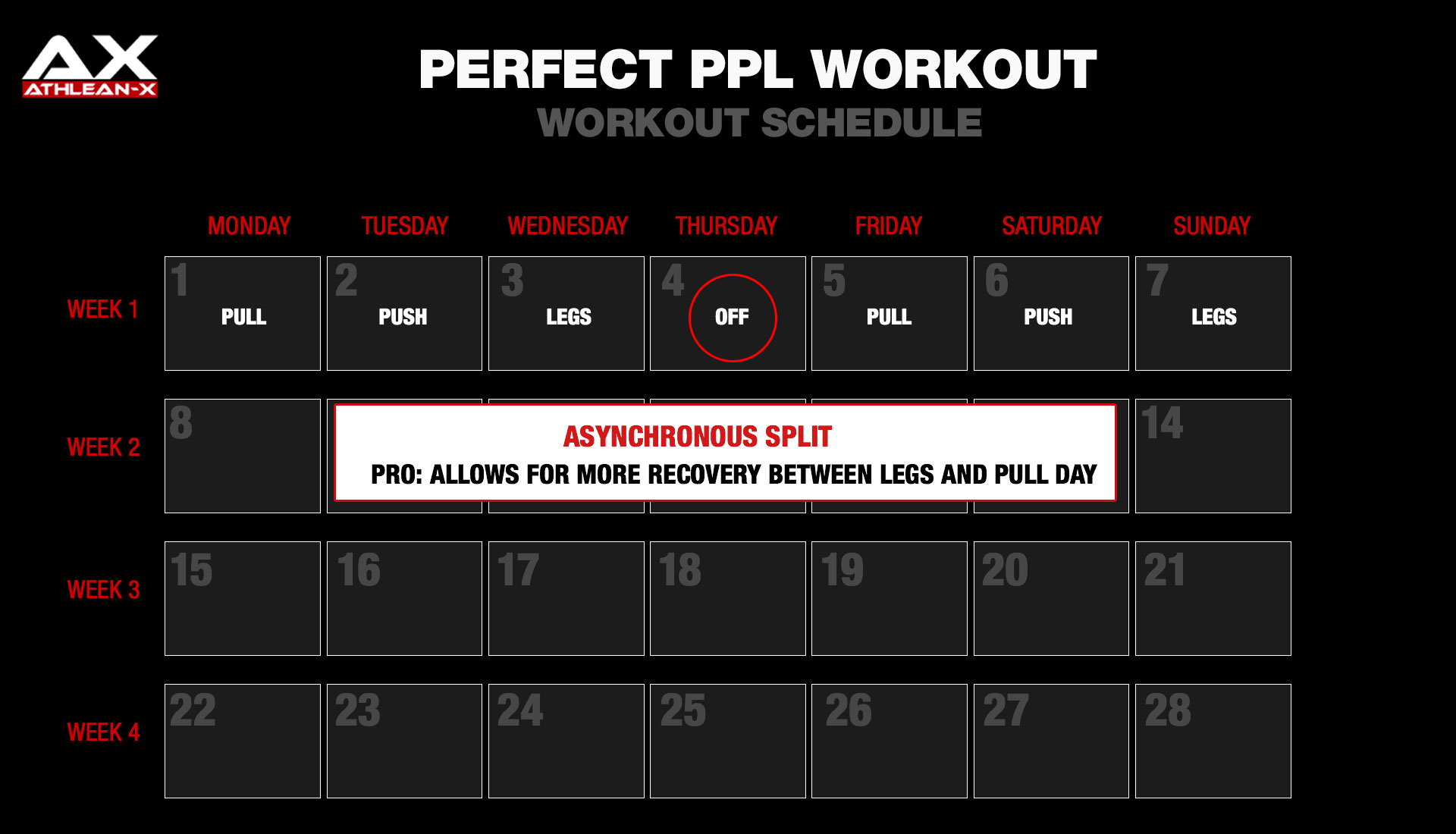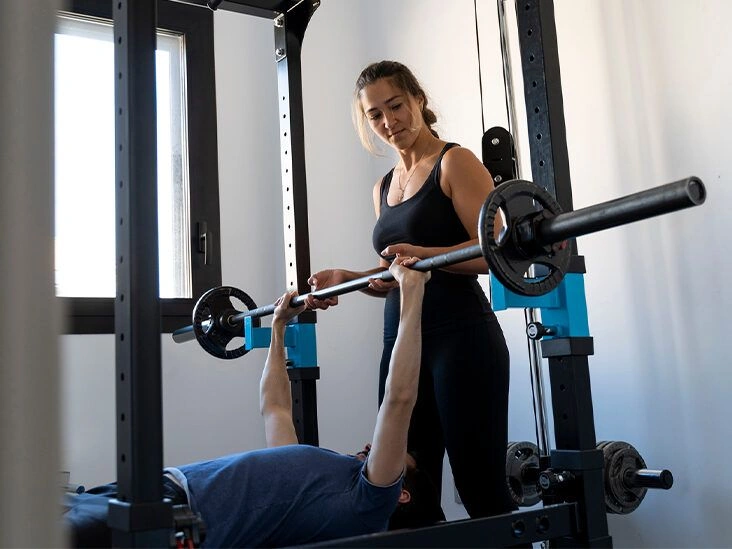Split training means breaking up your weekly exercise sessions or total training volume into separate days so you can concentrate on specific elements. Common formats include full-body sessions or push/pull/legs arrangements.
Workout splits typically group exercises by muscle regions to optimize energy, performance, and strength for particular muscles.
In resistance training, the primary muscle groupings are:
- Upper body: chest, back, shoulders, and abdominals
- Lower body: quadriceps, hamstrings, glutes, and calves
Workouts can also focus on smaller muscles within these larger categories, but trainers often use these major groups to create a clear split routine. Examples include full-body and upper/lower splits.
Another popular approach is the push/pull/legs split, which organizes sessions by movement patterns instead of individual muscles.
No matter which split you select, maintaining a balanced diet and allowing adequate recovery between sessions is vital. These strategies help reduce injury risk and enhance your strength-training progress.
Continue reading to explore the advantages of split routines and the most common templates so you can pick one that matches your goals and experience level.
Benefits of split training
Dividing training across the week provides several advantages, such as enhancing strength and muscle growth while lowering the chance of overuse injuries.
Rest and recovery
A major benefit of split routines is that they allow muscles sufficient time to recover.
Specialists suggest letting muscles rest for 48 hours between sessions targeting the same group. For instance, if you work a muscle on Monday evening, it’s generally best to wait until Wednesday evening to train it again.
Many common splits are designed around this 48-hour recovery window but implement it differently.
For example, a full-body plan trains all major muscles in one session. If you exercise on Monday, you could repeat the session on Wednesday and again on Friday.
By contrast, the upper/lower split separates upper- and lower-body sessions so the muscles trained on one day rest while you work the other area the next day.
Maximize strength during your workout
Using a split can help you prioritize certain muscles or movement patterns when you’re freshest at the start of a workout.
Research indicates that the order of exercises influences performance across multiple sets. This means later movements in a session may suffer compared with the first ones.
For example, squatting before bench pressing might limit how effectively you perform the bench press.
To optimize whole-body strength, schedule different primary lifts on separate days. Instead of bench pressing after squats, perform the bench press as the priority on one day and squat first on another.
Exercise variety
Splitting workouts enables you to include varied exercises across the week that emphasize particular body parts. If you train biceps twice a week, for instance, you could do hammer curls one session and preacher curls the other.
This approach adds variety to your training while targeting different portions of a muscle and enhancing range of motion.
Sticking to a weekly routine
A structured split helps you weave exercise into your weekly schedule and, crucially, maintain consistency.
If you have about 30 minutes for workouts on 4 to 7 days per week, you might train upper body twice and lower body twice.
If you only have 2 or 3 days but longer sessions available, a full-body split could be more suitable.
Whichever format you choose, consistency is the key to seeing progress.
1. Full-body split
This is the most straightforward layout. It involves training all major muscles 2 to 3 times per week with at least one full day off between sessions.
A full-body split is a solid choice if:
- you’re new to resistance training
- you can only train a few days per week
- you’re complementing other activities (like sports) with one or two weekly weight sessions
Hitting the entire body multiple times weekly with compound movements that involve several muscles simultaneously can be demanding yet effective.
A study found that, when weekly volume was matched, two full-body sessions per week produced similar strength and hypertrophy gains compared with a four-day split targeting muscles separately.
Example:
3-day split
Perform one exercise per body region for 2 to 3 sets of 8 to 12 reps.
- Day 1: full-body routine
- Day 2: rest
- Day 3: full-body routine
- Day 4: rest
- Day 5: full-body routine
- Day 6: rest
- Day 7: rest
If time is limited, consider supersets—doing one set of two exercises back to back before resting. For example, one set of bench press immediately followed by one set of split squats counts as a single superset.
Supersets can produce comparable strength and hypertrophy outcomes to single-exercise sets while reducing gym time.
2. Upper/lower split
In this split, you alternate upper-body training one session and lower-body training the next session, then repeat the cycle.
This can be arranged as a 4-day split with rest days between cycles or as a 6-day split where you alternate upper and lower sessions before taking a day off.
4-day split
Perform two exercises per body region for 3 to 4 sets of 6 to 12 reps.
- Day 1: upper body routine
- Day 2: lower body routine
- Day 3: rest
- Day 4: upper body routine
- Day 5: lower body routine
- Day 6: rest
- Day 7: rest
6-day split
Perform two exercises per body part for 3 sets of 6 to 12 reps.
- Day 1: upper body routine
- Day 2: lower body routine
- Day 3: upper body routine
- Day 4: lower body routine
- Day 5: upper body routine
- Day 6: lower body routine
- Day 7: rest
3. Push, pull, and legs split
The push/pull/legs framework groups workouts by upper-body movement patterns and the lower body, instead of by isolated muscles. For example:
- Push: muscles used for pushing — shoulders, chest, triceps
- Pull: muscles used for pulling — back, biceps, forearms
- Legs: lower-body muscles — quads, glutes, hamstrings, calves
This split is generally more suitable for intermediate to advanced trainees than the full-body or upper/lower arrangements.
Examples:
6-day split
Perform 3 to 4 exercises per session targeting the involved muscles for 3 to 4 sets of 6 to 12 reps.
- Day 1: push — chest, shoulders, triceps
- Day 2: pull — back, biceps, forearms
- Day 3: legs — quads, glutes, hamstrings, calves
- Day 4: push — chest, shoulders, triceps
- Day 5: pull — back, biceps, forearms
- Day 6: legs — quads, glutes, hamstrings, calves
- Day 7: rest
Push/pull split with integrated leg work
Some lifters include leg movements that align with push/pull patterns for more balanced full-body sessions. For example:
- Push: include squatting movements like squats, leg extensions, and calf raises
- Pull: include hinge-style moves like deadlifts and hamstring curls
Alternatively, leg days can be split into squat-focused and hinge-focused sessions. Perform 3 to 4 exercises for 3 to 4 sets of 6 to 12 reps:
- Day 1: push — chest, shoulders, triceps
- Day 2: squat — quads, calves
- Day 3: pull — back, biceps, forearms
- Day 4: hinge — glutes, hamstrings, abs
- Day 5: rest
»Learn more:Routines and Guide for Building Muscle with Push-Pull Workouts

4. Individual body-part split
With this approach, you target one or two specific body parts per session, typically training each muscle group only once weekly.
The National Academy of Sports Medicine refers to this as the “bro split.” Its benefits are often assumed, although scientific support is mixed.
This plan can include 5 to 6 training days depending on whether legs are split across one or two sessions.
It’s well suited for those prioritizing hypertrophy. A small 2021 study found that while full-body routines were superior for strength, split programs were more effective at stimulating muscle growth in some contexts.
You can use a wide variety of exercises and accumulate high session volume to thoroughly fatigue specific muscle groups.
This format can also be useful for addressing a particular muscle imbalance.
Examples:
5-day split
Perform 4 to 5 exercises for the targeted muscles with 3 to 4 sets of 6 to 15 reps.
- Day 1: chest
- Day 2: back
- Day 3: shoulders
- Day 4: rest
- Day 5: legs
- Day 6: arms
- Day 7: rest
6-day split
Perform 4 to 5 exercises for each target area with 3 to 4 sets of 6 to 15 reps.
- Day 1: chest
- Day 2: quads/calves
- Day 3: back
- Day 4: shoulders
- Day 5: hamstrings/lower back
- Day 6: arms
- Day 7: rest
What to consider when designing a split workout schedule
All of these structures can be effective. The key is picking the one that suits you best and that you can consistently follow, which you may discover through experimentation.
If you’re new to lifting or only have 2 to 3 days available, try a full-body split first.
As you add more sessions, consider moving to an upper/lower plan. If you extend training to six days, the push/pull/legs format or a body-part split could be appropriate.
A 2018 review concluded that for strength gains, training anywhere from 2 to 5 days per week can be equally effective so long as total weekly volume is matched.
Thus, if your aim is to increase strength, choose the split that best fits your schedule.
Tips for split workout training
Use these suggestions when planning a split routine:
- Recovery: Make sure muscles have time to recuperate. If you follow a 4- or 6-day plan and a muscle isn’t rested before its next session, reduce per-session volume or switch to a program with more recovery between training the same area.
- Strength: If strength is your priority, the full-body or push/pull/legs splits provide frequent exposure to compound lifts.
- Legs: If you tend to neglect leg training, adopt a full-body routine to ensure you consistently target lower-body muscles.
- Abs: If you want to add dedicated abdominal work, schedule it on whatever training day is least fatiguing for the rest of your body.
- Seek guidance: If you’re unsure where to begin or which plan matches your lifestyle and goals, consider consulting a certified personal trainer.
The bottom line
Split routines are organized strength-training programs that allow you to target all the muscles in your body.
There are many effective ways to divide your workouts.
Pick a split that fits your schedule and that you enjoy. If you can sustainably recover from six days of training, that approach may work well. If you only have 2 or 3 days available, a full-body split can be equally productive.
Ultimately, long-term consistency is the most important factor driving results from any training plan.


















Leave a Reply
You must be logged in to post a comment.